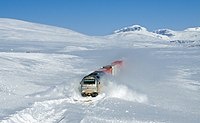
Photo from wikipedia
Abstract. Snow avalanches pose serious hazard to people and property in snow bound mountains. Snow mass sliding downslope can gain sufficient momentum to destroy buildings, uproot trees and kill people.… Click to show full abstract
Abstract. Snow avalanches pose serious hazard to people and property in snow bound mountains. Snow mass sliding downslope can gain sufficient momentum to destroy buildings, uproot trees and kill people. Forecasting and in turn avoiding exposure to avalanches is a much practiced measure to mitigate hazard world over. However, sufficient snow stability data for accurate forecasting is generally difficult to collect. Hence forecasters infer snow stability largely through intuitive reasoning based upon their knowledge of local weather, terrain and sparsely available snowpack observations. Machine learning models may add more objectivity to this intuitive inference process. In this paper we propose a data efficient machine learning classifier using the technique of Random Forest. The model can be trained with significantly lesser training data compared to other avalanche forecasting models and it generates useful outputs to minimise and quantify uncertainty. Besides, the model generates intricate reasoning descriptions which are difficult to observe manually. Furthermore, the model data requirement can be met through automatic systems. The proposed model advances the field by being inexpensive and convenient for operational use due to its data efficiency and ability to describe its decisions besides the potential of lending autonomy to the process.
Journal Title: Natural Hazards and Earth System Sciences
Year Published: 2021
Link to full text (if available)
Share on Social Media: Sign Up to like & get
recommendations!